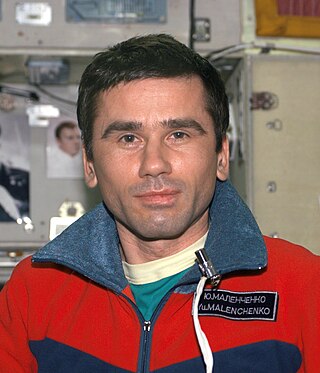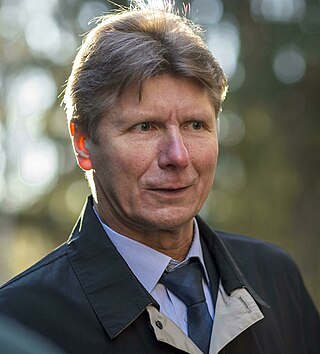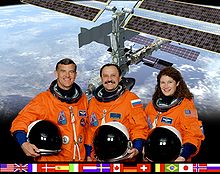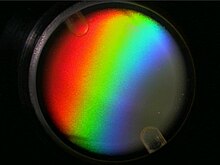
Mir was a space station that operated in low Earth orbit from 1986 to 2001, operated by the Soviet Union and later by Russia. Mir was the first modular space station and was assembled in orbit from 1986 to 1996. It had a greater mass than any previous spacecraft. At the time it was the largest artificial satellite in orbit, succeeded by the International Space Station (ISS) after Mir's orbit decayed. The station served as a microgravity research laboratory in which crews conducted experiments in biology, human biology, physics, astronomy, meteorology, and spacecraft systems with a goal of developing technologies required for permanent occupation of space.

Yuri Ivanovich Malenchenko is a retired Russian cosmonaut. Malenchenko became the first person to marry in space, on 10 August 2003, when he married Ekaterina Dmitrieva, who was in Texas, while he was 240 miles (390 km) over New Zealand, on the International Space Station. As of December 2023, Malenchenko ranks third for career time in space due to his time on both Mir and the International Space Station (ISS). He is a former commander of the International Space Station.

Yury Valentinovich Lonchakov is a Russian former cosmonaut and a veteran of three space missions. He has spent 200 days in space and has conducted two spacewalks. From 2014 to 2017, Lonchakov served as head of the Yuri Gagarin Cosmonaut Training Center.

STS-106 was a 2000 Space Shuttle mission to the International Space Station (ISS) flown by Space Shuttle Atlantis.

Yuri Pavlovich Gidzenko is a Russian cosmonaut. He was a test cosmonaut of the Yuri Gagarin Cosmonaut Training Center (TsPK). Gidzenko has flown into space three times and has lived on board the Mir and the International Space Station. He has also conducted two career spacewalks. Although he retired on July 15, 2001, he continued his employment by a special contract until Soyuz TM-34 concluded. Since 2004 to May 2009, Gidzenko was the Director of the 3rd department within the TsPK. Since May 2009 he serves as the Deputy Chief of Cosmonaut Training Center TsPK.

Valery Grigoryevich Korzun is a former Russian cosmonaut. He has been in space twice totalling 381 days. He has also conducted four career spacewalks.

Col. Yuri Ivanovich Onufrienko is a retired Russian cosmonaut. He is a veteran of two extended spaceflights, aboard the space station Mir in 1996 and aboard the International Space Station in 2001–2002.

Gennady Ivanovich Padalka is a Russian Air Force officer and Roscosmos cosmonaut. Padalka held the world record for the most time spent in space at 878 days until Oleg Kononenko broke this record on February 4, 2024 at 07:30:08 UTC and is currently at 2nd position. He worked on both Mir and the International Space Station.

Vladimir Nikolayevich Dezhurov is a Russian former cosmonaut who resides in Star City, Moscow. He is a veteran of two spaceflights, to the Mir and International Space Stations. During his career, Dezhurov also conducted nine spacewalks before his retirement on July 12, 2004.

Mikhail Vladislavovich Tyurin is a former Russian cosmonaut who flew several missions to the International Space Station and completed four spacewalks during his career. He was awarded the title Hero of the Russian Federation for his work as a cosmonaut.

Yury Vladimirovich Usachov is a former cosmonaut who resides in Star City, Moscow. Usachov is a veteran of four spaceflights, including two long-duration missions on board the Mir Space Station and another on board the International Space Station. During his career, he also conducted seven spacewalks before his retirement on April 5, 2004.

James Shelton Voss is a retired United States Army colonel and NASA astronaut. During his time with NASA, Voss flew in space five times on board the Space Shuttle and International Space Station. He also served as deputy of Flight Operations for the Space Station Program Mission Integration and Operations Office. While participating in ISS Expedition 2, he and Susan Helms conducted an 8-hour and 56 minute spacewalk, the longest to date.

Fyodor Nikolayevich Yurchikhin is a Russian cosmonaut of Greek descent, engineer and RSC Energia test-pilot who has flown on five spaceflights. His first spaceflight was a 10-day Space Shuttle mission STS-112. His second was a long-duration stay aboard the International Space Station (ISS) as a flight engineer for Expedition 15; for this mission he was launched in the Soyuz TMA-10 spacecraft. He has undertaken two further long-duration stays aboard the ISS, as a crew member of Expedition 24 / 25. For this mission he was launched with the spacecraft Soyuz TMA-19, and he landed in November 2010, also with the Soyuz TMA-19 spacecraft. He served as Soyuz commander for his fourth mission aboard Soyuz TMA-09M, as flight engineer for Expedition 36 and ISS commander for Expedition 37. In April 2017, Yurchikhin launched on Soyuz MS-04 for the fifth spaceflight of his career, a six-month mission to the ISS as part of Expedition 51 and 52, for which he was the commander.

Pavel Vladimirovich Vinogradov is a former cosmonaut and commander of the International Space Station. He has flown into space three times, aboard Mir and the International Space Station, and was one of the top 10 astronauts in terms of total time in space after his third spaceflight. Vinogradov has also conducted seven spacewalks in his cosmonaut career, and holds the record for the oldest person to perform a spacewalk.

Expedition 1 was the first long-duration stay on the International Space Station (ISS). The three-person crew stayed aboard the station for 136 days, from November 2000 to March 2001. It was the beginning of an uninterrupted human presence on the station which continues as of 2024. Expedition 2, which also had three crew members, immediately followed Expedition 1.

Pirs(Russian: Пирс, meaning "pier") – also called Stykovochny Otsek 1 and DC-1 – was a Russian module on the International Space Station (ISS). Pirs was launched on 14 September 2001, and was located on the Zvezda module of the station. It provided the ISS with one docking port for Soyuz and Progress spacecraft, and allowed egress and ingress for spacewalks by cosmonauts using Russian Orlan space suits. Pirs was docked to Zvezda for almost 20 years, until 26 July 2021, where it was decommissioned and undocked by Progress MS-16 to make way for the new Nauka module.

The Shuttle–Mir program was a collaborative 11-mission space program between Russia and the United States that involved American Space Shuttles visiting the Russian space station Mir, Russian cosmonauts flying on the Shuttle, and an American astronaut flying aboard a Soyuz spacecraft to engage in long-duration expeditions aboard Mir.

Expedition 14 was the 14th expedition to the International Space Station (ISS). Commander Michael López-Alegría, and flight engineer Mikhail Tyurin launched from Baikonur Cosmodrome on 18 September 2006, 04:09 UTC, aboard Soyuz TMA-9. They joined Thomas Reiter, who had arrived at the ISS on 6 July 2006 aboard Space Shuttle Discovery during mission STS-121. In December 2006, Discovery mission STS-116 brought Sunita Williams to replace Reiter as the third member of Expedition 14. On 21 April 2007, López-Alegría and Tyurin returned to Earth aboard TMA-9. Landing occurred at 12:31:30 UTC.

Mir EO-19 was the nineteenth crewed expedition to the space station Mir, lasting from June to September 1995. The crew, consisting of Russian cosmonauts Anatoly Solovyev and Nikolai Budarin, launched on June 27, 1995 aboard the Space Shuttle Atlantis on the STS-71 mission. After remaining aboard Mir for approximately 75 days, Solovyev and Budarin returned aboard the Soyuz TM-21 spacecraft on September 11, 1995.



























